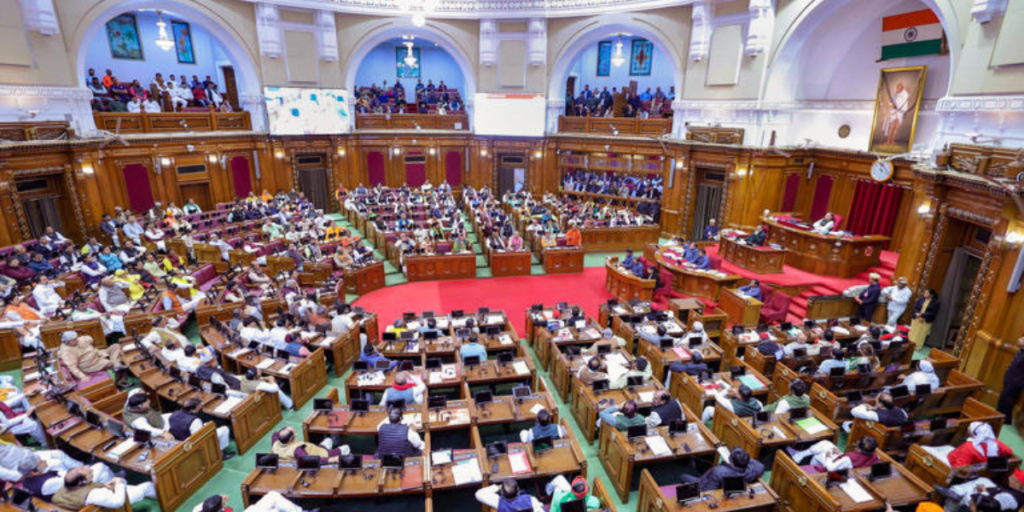In a noteworthy development reminiscent of the aftermath of the Ayodhya verdict, Uttar Pradesh Chief Minister Yogi Adityanath has sparked discussions around a temple-mosque dispute, this time focused on Mathura. Against a charged backdrop, Adityanath invoked the ‘Sanatan’ ethos, blending historical and religious narratives to champion the construction of a temple on the site currently hosting a mosque. This move draws striking parallels with recent events in Ayodhya and Varanasi, amplifying the ‘Sanatan’ perspective in the ongoing discourse.
Table of Contents
Mathura in Focus:
Addressing the assembly during a debate on the Governor’s Address, CM Yogi Adityanath ignited discussions surrounding the Mathura temple-mosque dispute. Drawing upon religious sentiments and historical narratives, Adityanath framed the issue within the context of the epic Mahabharata, referencing the Pandavas’ quest for land and their symbolic association with Ayodhya, Kashi, and Mathura.

The ‘Sanatan’ Perspective: Historical Claims and Religious Significance
Central to the discourse is the ‘Sanatan’ perspective, which emphasizes the historical and religious significance of Ayodhya, Kashi, and Mathura as sacred sites deeply embedded in Hindu mythology and tradition. Adityanath’s invocation of ‘Sanatan’ values underscores the broader narrative of cultural preservation and religious heritage that underpins the temple-mosque disputes across Uttar Pradesh.
Ayodhya Echoes:
The reference to Ayodhya serves as a potent backdrop to the Mathura debate, with Adityanath drawing parallels between the two historical sites. Reflecting on the recent consecration ceremony at the Ram temple in Ayodhya, Adityanath juxtaposed the celebratory fervor with the perceived neglect of developmental initiatives under the previous Samajwadi Party government. The juxtaposition of festivities and developmental discourse underscores the multifaceted dimensions of the temple-mosque disputes and their implications for governance and socio-political dynamics.

Kashi Vishwanath:
The mention of the Kashi Vishwanath shrine in Varanasi further amplifies the discourse surrounding temple-mosque disputes in Uttar Pradesh. Adityanath’s allusion to recent legal proceedings and symbolic gestures, such as the court order allowing Hindu priests access to the Gyanvapi mosque cellar, underscores the complex interplay between legal frameworks, historical narratives, and religious sentiments.

Mathura’s Dilemma:
At the heart of the Mathura temple-mosque dispute lies a complex interplay of historical claims, legal implications, and religious sentiments. The assertion that the Shahi Idgah stands on the alleged birthplace of Lord Krishna, adjacent to a Krishna temple, underscores the contested nature of sacred spaces and the competing narratives that define India’s religious landscape. The invocation of historical grievances and legal precedents underscores the stakes involved in the resolution of temple-mosque disputes and their broader implications for communal harmony and legal jurisprudence.
Beyond Temple-Mosque Disputes
Amidst the contentious debates surrounding temple-mosque disputes, Adityanath’s emphasis on development initiatives in Ayodhya raises pertinent questions about governance, accountability, and socio-economic progress. The juxtaposition of temple-mosque disputes with issues of infrastructure, healthcare, and sanitation underscores the multidimensional challenges facing Uttar Pradesh and the imperative of inclusive development that transcends religious divides.
Conclusion:
As Uttar Pradesh grapples with the legacy of temple-mosque disputes, the discourse surrounding Mathura emerges as a microcosm of larger debates surrounding identity, history, and religious pluralism in India. The invocation of ‘Sanatan’ values and historical narratives underscores the enduring significance of religious heritage in shaping collective consciousness and socio-political dynamics. As stakeholders navigate the complexities of temple-mosque disputes, the quest for resolution and reconciliation remains paramount, with implications extending far beyond legal frameworks and political rhetoric.

In the final analysis, the Mathura temple-mosque dispute underscores the complexities of religious pluralism and cultural heritage in contemporary India. As Uttar Pradesh navigates the intersection of history, law, and religious sentiment, the path towards resolution and reconciliation remains fraught with challenges yet laden with the potential for dialogue, understanding, and mutual respect. Only through sustained engagement and inclusive governance can the legacy of temple-mosque disputes be transformed into a catalyst for unity, harmony, and collective progress.

